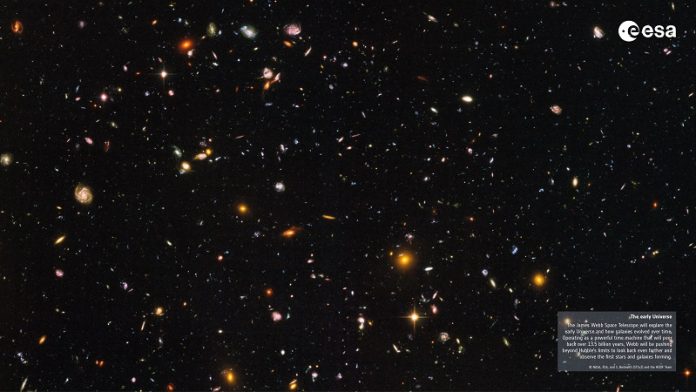
Ever wondered how our universe began and how the first galaxies formed?
Well, scientists have been asking the same questions, and now, thanks to a powerful space telescope and some super-smart computer work, we’re getting closer to the answers!
The James Webb Space Telescope (JWST), an amazing space eye, gave us some unexpected pictures of the universe’s baby years.
It showed early galaxies that looked different than what many scientists thought they would – they were brighter and seemed bigger.
It was like expecting to see a toddler and finding a teenager instead!
A group of researchers from Maynooth University in Ireland and the Georgia Institute of Technology in the US decided to take a deeper look. They ran computer simulations to recreate the universe’s early days.
Think of it like a super-detailed video game where they can watch galaxies being born and grow. This study was then shared with everyone in The Open Journal of Astrophysics.
The computer program they used, called the “Renaissance simulations”, is really special. It can show tiny clumps of an invisible thing called “dark matter” coming together.
As these clumps join up, they form bigger clumps or “halos” where galaxies begin to appear.
This computer program can also show the very first stars being born. These stars, called Population III stars, were not like the ones we see in our night sky today. They were believed to be bigger and much brighter.
What’s cool is that the results from this computer simulation matched with what the JWST telescope was showing. So, even though the early galaxies looked surprising at first, they actually make sense when you look at the detailed computer models.
Joe M. McCaffrey, the main person behind the study and a student at Maynooth University, was excited about the results.
He said that these computer models help us understand where we come from in this vast universe.
In the future, they hope to use the same computer program to see how massive black holes (those mysterious areas in space where gravity is so strong that nothing, not even light, can escape) came to be in the early universe.
Dr. John Regan, another scientist on the team, is amazed by the JWST telescope’s power. He mentioned how this space telescope lets us peek at the universe when it was very young, like a little baby, just a few hundred million years old after the Big Bang.
To put it in perspective, imagine the universe is now 100 years old; back then, it was not even 1 year old!
Dr. Regan explained that this young universe was full of action: big stars forming everywhere and black holes growing. And now, with the help of the JWST’s pictures, they can improve their computer models. It’s like using real-life photos to make a video game more realistic.
In simple terms, by working together, the powerful telescope and the computer simulations are helping scientists unravel the universe’s earliest and most mysterious stories. It’s an exciting time for space fans everywhere!
Follow us on Twitter for more articles about this topic.



